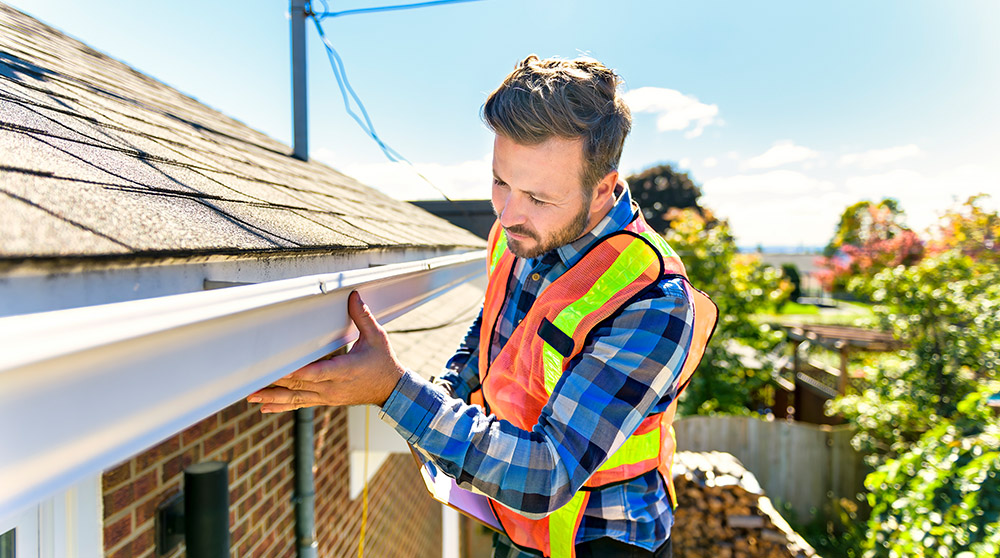How to prevent water damage in your home.

Did you know water damage is one of the most common and costliest home insurance claims? Responsible for billions of dollars in damage every year, it can wreak havoc on your property and pose health risks to you and your family. However, with proper planning and proactive maintenance, you can significantly reduce your risk. To learn how to prevent water damage in your home, read on for our expert advice.
Regularly inspect your roof. The first line of defense against water damage is a well-maintained roof. Inspect yours at least twice a year and be on the lookout for missing or damaged shingles, cracks, or leaks. Promptly address any issues that may arise. (For more, read: Does your roof need to be repaired or replaced?) Additionally, if you have a chimney, look at its exterior for loose mortar or cracked bricks and seal as needed. You can also inspect from the inside of the attic. If you see signs of leakage or light coming through, it may be time to call a professional for a full inspection and repair.
Keep gutters and downspouts clean. Clogged gutters and downspouts can cause water to overflow and accumulate near your home’s foundation, which could lead to structural damage. We recommend inspecting your gutters and downspouts twice a year and removing any debris — such as leaves, branches, or dirt — that may be blocking the flow of water. Additionally, make sure downspouts are secured and directed away from your home’s foundation to prevent basement flooding and foundational issues.
Seal basements and crawl spaces. Moisture intrusion in basements and crawl spaces can lead to mold growth and structural damage. To prevent this, ensure your basement walls and floors are properly sealed and waterproofed. You should also inspect your foundation for cracks and promptly repair any issues you discover. If you use your basement for storage, invest in waterproof bins and keep your belongings stored on shelving units — not the floor. Never store high-value items in these areas that are more susceptible to water accumulation and moisture.
Inspect and maintain appliances. Regularly inspecting and maintaining appliances that use water, such as washing machines, dishwashers, and water heaters, can lessen the likelihood of a leak. Check for signs of wear on hoses and connections annually and replace them as needed. Investing in floor pans to place under appliances is an inexpensive way to catch early indications of a problem and prevent damage.
Use water sensors. A water detector is a small electronic device that can alert you of potential leaks or flooding, so you can protect your property and minimize the potential for costly repairs. Place them near appliances like washing machines, hot water heaters, dishwashers, sump pumps, and toilets, as well as in your basement and other areas susceptible to flooding.
Know where your water main is. In case of a burst pipe or extensive leak, quickly shutting off the main water supply can help minimize the damage to your home. With that, you’ll want to make sure everyone who lives with you knows where it is and how it works.
Keep a close eye on your water bill. Don’t let water damage drain your bank account. Monitor your monthly bill so you know how much water you usually use, and if you see a significant spike, seemingly without an explanation, look for a leak.
Inspect the sump pump. Usually located in the basement or crawl space, your home’s sump pump can help prevent interior flooding by removing excess water. You can routinely inspect this by ensuring the pump is connected to the GFCI electrical outlet and is pouring water into the sump pit. If it’s working properly, the pump should turn on and remove the water.
Switch to PEX pipes. If you have an older home, it’s likely you have copper piping, which was the standard for decades. Unfortunately, due to the nature of this material, it has been phased out for good reason. Soldered joints and corrosion can develop pinhole leaks that will drip and wreak havoc on ceilings and walls. While replumbing an entire home can be costly, making incremental swaps for corrosion-free plastic PEX pipes will pay dividends.
Understandably, water damage can be an overwhelming burden for homeowners, as it can lead to costly repairs, decrease the value of your property, pose risks to your health, and disrupt your normal routine. That’s why keeping a detailed and up-to-date home inventory is important if you have to file a claim. Having a comprehensive record of what is in your home and how much it cost can save you time and help expedite the claims filing process. Don’t have a home inventory? It’s never too late to start one. Read: How to do a home inventory.
Now that you know how to prevent water damage in your home, the next step is talking to an agent about your insurance. Make sure you know what type of water damage is included in your homeowners policy, and what options are available to add onto it. To start a conversation now, find a local, independent agent near you.







